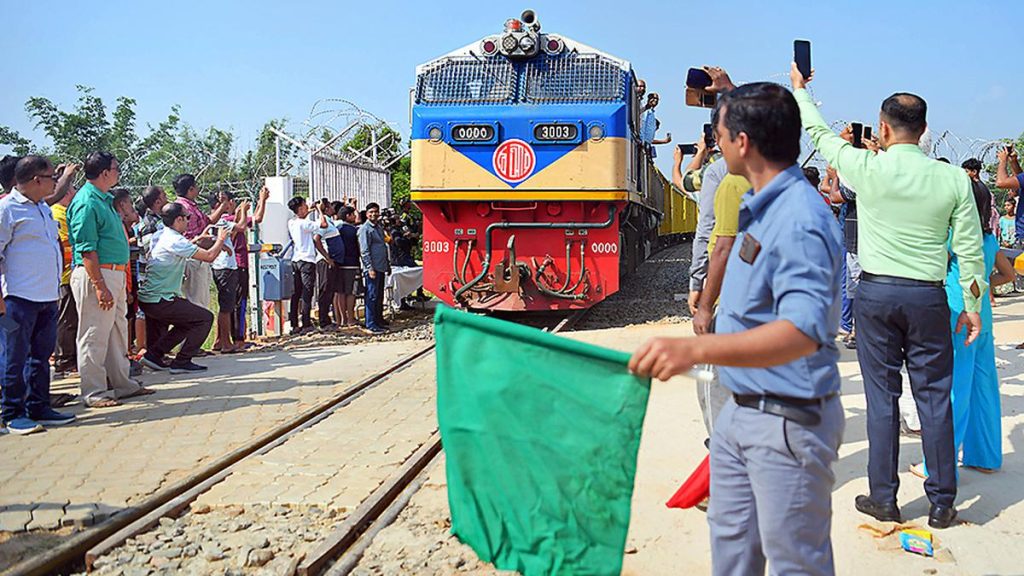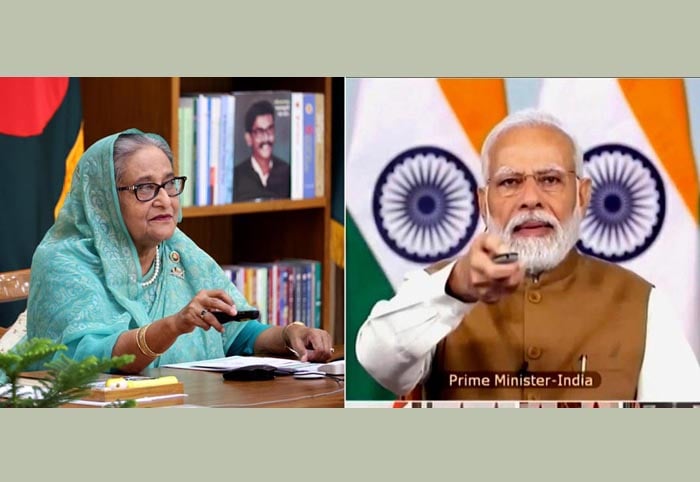Significance of the Akhaura-Agartala Rail Link for India and Bangladesh
The Akhaura-Agartala rail link is a major milestone in India-Bangladesh cooperation, enhancing connectivity, trade, and people-to-people contact

By SOHINI BOSE and ANASUA BASU RAY CHAUDHURY
As 2023 draws to a close, a decade-old Memorandum of Understanding (MoU) between India and Bangladesh, to set up the first Indo-Bangla international railway connectivity in India’s Northeast, has found fruition in the recently launched Akhaura-Agartala cross-border rail link. Inaugurated digitally by Indian Prime Minister Narendra Modi and Bangladesh Prime Minister Sheikh Hasina, this railway connects, Agartala—the capital city of India’s Northeastern state, Tripura—with the Akhaura upazila in Bangladesh’s Bahmanbaria district. The connectivity through Bangladesh helps bypass the long, narrow, and congested Siliguri Corridor, also known as the ‘Chicken’s Neck’ which connects the Northeast to India’s mainland. In effect, this reduces the traveling distance from India’s Northeastern states such as Mizoram, and southern parts of Assam to Kolkata. For Tripura particularly, the distance to Kolkata by rail is reduced from 1,600 km to 500 km and the duration is reduced from 31 hours to 10 hours, approximately.
The port of Ashuganj, which is located near Akhaura, is expected to ferry goods to and from the station to the Port of Chattogram. That apart several rail, road, and river networks also connect Akhaura with many industrial sectors in Bangladesh such as Dhaka, Chattogram, and Sylhet. Accordingly, for Bangladesh, the rail link bears the promise of increased trade with India, its second-largest trading partner. In this regard, it has been pointed out that the link will boost bilateral trade, in agriculture such as tea, sugar, construction items, iron and steel, and consumer products.

Re-tracing historical linkages
Before Bangladesh’s birth in 1971, the junction at Akhaura was used by people traveling from India’s Northeast to Kolkata or seeking access to the markets of East Pakistan. The Liberation War and its associated complications had, however, halted the practice, leaving the only alternative the Siliguri Corridor, which is a difficult route to transport goods and heavy machinery given its steep roads with hairpin bends. As a result, India has been requesting Bangladesh for the Akhaura-Agartala rail link ever since 1974, following the signing of a protocol for cross-traffic movement. However, the idea remained dormant, surfacing briefly in 1998, during the Trade Review Talks between India and Bangladesh. Another decade later, the construction of this rail link was announced in a Joint Communique that was published during Prime Minister Hasina’s visit to India in January 2010. It was agreed that the line would run from Agartala to Gangasagar in Bangladesh with a double line from Gangasagar to Akhaura and two additional loop lines at Gangasagar and Imambari stations of Bangladesh Railways. The project was to be implemented by the North Frontier Railway and funded mostly by the Indian Ministry of External Affairs and partly by the Indian Department of North-Eastern Region.

Overcoming impediments
Although the project commenced in 2016, several challenges hindered the process. The primary one was that many in Bangladesh believed that India sought transit through their territory to open up its landlocked northeast, but in return, Dhaka would not be given any access to it nor the rest of India. A few sections in Bangladesh even interpreted India’s requests as a ploy to undermine its sovereignty. Dhaka, thus, made the project conditional upon India allowing transit to Nepal and Bhutan via its territory to use the Chattogram Port. Currently, both the Himalayan countries use this port, via India, and in 2020, India agreed to open new trade routes in Agartala to further facilitate Bhutan’s transit trade with Bangladesh.
Perceptions aside, financial issues also delayed the completion of the rail link project. Initially, INR 972.52 crore had been sanctioned, of which INR 580 crore was allotted for work on the Indian side and INR 392.52 crore was reserved for Bangladesh. Eventually, the fund was revised twice due to increased costs and other associated expenses, and the final charge is estimated at INR 1,255.1 crore of which INR 862.58 crore is for the work on India’s side.
The unforeseen onset of COVID-19 presented another set of challenges, further delaying the process, but its lessons on the importance of supply chains provided the necessary impetus to both countries to ensure the completion of the project post-pandemic. Accordingly, at the end of October 2023, the first trial run was conducted, from Nishchintapur a designated Land Customs Station in India to the Gangasagar station near Akhaura. Off the entire railway line of 12.24 km, Tripura has a track of 5.46 km in broad gauge, and Akhaura has a meter gauge track of 6.78 km. The international immigration will take place at the Nischintapur dual gauge station, catering to both passenger and goods interchange. The rail link marks the otherwise landlocked Tripura, as the ‘Gateway to the Northeast’.
Geopolitical significance
As India and Bangladesh share a contiguous terrain, they are natural partners in connectivity initiatives, and projects such as the Akhaura-Agartala rail link help realise the potential of this geographical continuity.
Therefore, the Akhaura-Agartala rail link while benefiting passenger and goods transfer on the ground, has also significantly advanced Indian foreign policy.
In recent years, India and Bangladesh have undertaken multiple projects to develop connectivity between the two countries, of which the Maitri Setu, inaugurated in 2021 is an important example. It connects Sabroom, the southernmost point of Tripura with the Chattogram Port and is designed to facilitate people’s movement from Cox’s Bazaar or the Chittagong Hill Tracts in Bangladesh to Tripura along with the transport of goods. The third integrated check post in Sabroom is expected to be shortly inaugurated, making the Maitri Setu functional and creating an avenue for trade between India’s Northeast and Southeast Asia. If connected with the Akhaura-Agartala rail link, the Maitri Setu will offer multi-modal connectivity to other key parts of Bangladesh as well.
Milestone in cooperation
The Akhaura-Agartala rail link is a major milestone in India-Bangladesh cooperation, enhancing connectivity, trade, and people-to-people contact. As Prime Minister Sheikh Hasina prepares for the upcoming general elections in Bangladesh that are scheduled to be held between December 2023-January 2024, the rail link is expected to add more credibility to her bid for a fourth term as Prime Minister, as she banks on the ‘development card’ for her victory. It is important to note herein that the Akhaura-Agartala rail link was inaugurated along with two other collaborative ventures; the Khulna-Mongla port rail line, and Unit II of the Maitree Super Thermal Power Plant in Bangladesh, both of which were financed by India.
India, too, faces elections in 2024, and a promise of ushering in prosperity in the Northeast bears well for the Modi government, especially since the Centre has been lately critiqued for its silence over the ethnic violence in Manipur. Additionally, good relations with the eastern neighbourhood, of which Bangladesh is an integral part, strengthen the popularity of the Modi government within the country, at the regional level, and even in the international arena.
Sohini Bose is an Associate Fellow at the Observer Research Foundation
Anasua Basu Ray Chaudhury is a Senior Fellow at the Observer Research Foundation




